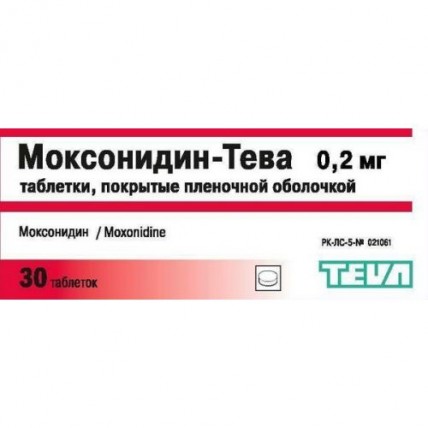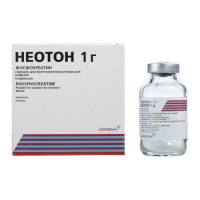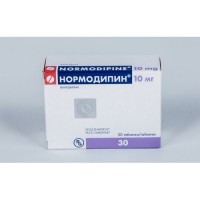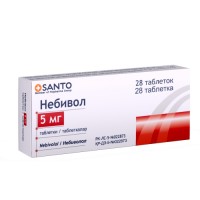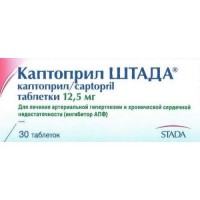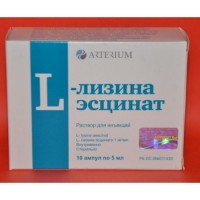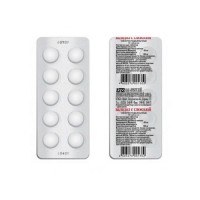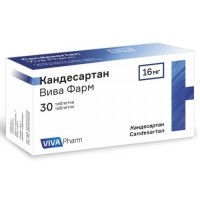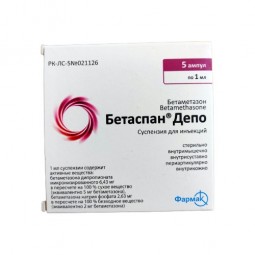Moxonidine-30s Teva 0.2 mg film-coated tablets
- $15.10
Out Of Stock
The instruction for medical use of Moksonidin-Tev Torgovoye medicine a name Moksonidin-Tev the International unlicensed name Moksonidin Lekarstvennaya the Tablet form, film coated, 0.2 mg and 0.4 mg Structure One tablet contains active agent – moksonidin 0.2 mg or 0.4 mg, excipients: lactoses monohydrate, krospovidon, povidone, magnesium stearate, structure of a film cover of Dyestuff Opadry Y-1-7000 white *: gland (III) oxide red (E172) * a gipromelloza, the titan dioxide (E171), polyethyleneglycol the Description of the Tablet, film coated light pink color, round shape, with a biconvex surface, diameter (6.0 ± 0.2) mm (for a dosage of 0.2 mg). Tablets, film coated dark pink color, round shape, with a biconvex surface, diameter (6.0 ± 0.2) mm (for a dosage of 0.4 mg). Pharmacotherapeutic group Hypotensive drugs. Adrenostimulyatora central. 2-adrenomimetika alpha central, derivative imidazoline. Moksonidin. The ATX C02AC05 code Pharmacological the Pharmacokinetics At properties intake moksonidin quickly and almost completely (Tmaks about 1 hour) is soaked up from upper parts of digestive tract. Absolute bioavailability - 88% that indicates lack of primary hepatic metabolism. Meal does not influence pharmacokinetics of a moksonidin. Communication with proteins of blood plasma makes 7.2%. In blood only one metabolite of a moksonidin – degidromoksonidin comes to light. Its pharmacological activity is 10 times less, than a moksonidina. Within 24 hours more than 78% of a moksonidin are removed by kidneys and 13% in the form of a degidromoksonidin. Other, less significant metabolites, are found in urine in number of about 8% of the entered dose. Less than 1% of a dose are removed with a stake in the form of metabolites. Elimination half-life of a moksonidin and its main metabolite makes 2.5 and 5 hours respectively. Pharmacokinetics at patients with arterial hypertension At patients with arterial hypertension changes of pharmacokinetics are not revealed. Pharmacokinetics at elderly At elderly patients the differences in pharmacokinetics of a moksonidin in comparison with persons of younger age generally caused by the lowered metabolic activity and/or increase in bioavailability at elderly are observed. However these distinctions of pharmacokinetics have no clinical importance. Pharmacokinetics at children and teenagers up to 18 years of the Research of pharmacokinetics at children and teenagers were not carried out. The pharmacokinetics in a renal failure Removal of a moksonidin substantially correlates with the clearance of creatinine (CC). Patients with a renal failure of moderate severity have (glomerular filtration rate (GFR) of 30-60 ml/min.) equilibrium concentration in blood plasma and final elimination half-life, respectively, in 2 and 1.5 times is higher, than at patients with hypertensia with normal function of kidneys (SKF & gt, 90 ml/min.). Moreover, the maximum concentration of a moksonidin in blood plasma are 1.5-2 times higher at patients with a renal failure of moderate severity. At patients with a heavy renal failure (SKF & lt, 30 ml/min.) equilibrium concentration in blood plasma and final elimination half-life is about 3 times higher, than at patients with arterial hypertension with normal function of kidneys. Reception of repeated doses does not lead to cumulation of a moksonidin in an organism of patients of this group. At patients in an end-stage of a renal failure (SKF & lt, 10 ml/min.) on dialysis, the area under curve (AUC) and terminal elimination half-life in 6 and 4 times, respectively, is higher, than at patients with normal function of kidneys. Therefore, the dose of a moksonidin at patients with a renal failure needs to be selected according to individual requirements. Moksonidin in insignificant degree is brought when carrying out a hemodialysis. The pharmacodynamics Moksonidin-Tev is antihypertensive drug. Available experimental data show that localization of action of a moksonidin is the central nervous system (CNS). It was shown what moksonidin selectively stimulates imidazolinovy receptors in a brain trunk. Imidazoline-sensitive receptors are concentrated in rostral department of a ventrolateralny part of a medulla - the site which is considered the center of regulation of peripheral sympathetic nervous system. At stimulation of imidazolinovy receptors the activity of sympathetic nervous system decreases and blood pressure goes down. Moksonidin differs from other sympatholytic antihypertensive drugs in low affinity to α2-адренорецепторам in comparison with imidazolinovy receptors. It the low probability of sedation and dryness in a mouth at reception of a moksonidin can speak. Moksonidin reduces arterial blood pressure as a result of reduction of system vascular resistance that is proved by clinical trials. Moksonidin improves sensitivity of fabrics to insulin for 21% in comparison with placebo at patients with obesity and insulin resistance with moderate arterial hypertension. Indications - essential (primary) hypertensia accept the Route of administration and doses of the Tablet inside, washing down with enough water, irrespective of meal. In most cases the initial dose Moksonidin-Tev makes 0.2 mg a day, the maximum daily dose which should be divided into 2 receptions makes 0.6 mg. The maximum single dose makes 0.4 mg. The dose and a course of treatment are selected individually, depending on the clinical answer. At patients with a moderate or heavy renal failure the initial dose of a moksonidin makes 0.2 mg a day. If necessary and good tolerance at patients with a moderate renal failure the dose of a moksonidin can be increased up to 0.4 mg a day. Use of a moksonidin for children and teenagers is younger than 18 years it is not recommended due to the lack of data on safety and efficiency. Side effects the Most frequent side effects about which it was reported at reception of a moksonidin include dryness in a mouth, dizziness, an asthenia and drowsiness. These symptoms often decrease after the first several weeks of treatment. The undesirable effects (observed during placebo - the controlled clinical trials with n=886 of the patients accepting moksonidin) are reflected in frequencies below: Very often (≥1/10) - dryness in a mouth it is frequent (≥1/100, & lt, 1/10) - dizziness / vertigo, a headache *, drowsiness, insomnia, an asthenia - diarrhea, nausea, vomiting, dyspepsia - rash, an itching - a dorsodynia Infrequently (≥1/1000. & lt, 1/100) - bradycardia, hypotension * (including orthostatic) - a Quincke's disease, peripheral hypostases - pain in a neck - a ring in ears - nervousness, a syncope * * frequency was comparable to Contraindication placebo - hypersensitivity to drug components - a sick sinus syndrome - bradycardia (heart rate at rest less than 50 in a minute) - atrioventricular block of II or III degree - heart failure - a heavy renal failure (SKF & lt, 30 ml/min., concentration of creatinine in blood serum & gt, 160 µmol/l) - children's and teenage age up to 18 years - pregnancy and the period of a lactation - hereditary intolerance of fructose, deficiency of Lapp-lactases enzyme, glucose galactose malabsorption Medicinal interactions At combined use of drug Moksonidin-Tev happens to other antihypertensives mutual strengthening of action. As tricyclic antidepressants can reduce efficiency of antihypertensive drugs of the central action, the concomitant use Moksonidin-Tev with drugs of this group is not recommended. Moksonidin-Tev can strengthen sedative effect of tricyclic antidepressants (it is necessary to avoid their joint appointment), tranquilizers, alcohol, sedative and sleeping medicines. Moksonidin-Tev moderately improves reduced cognitive ability at the patients accepting lorazepam. Moksonidin-Tev enhances sedation of benzodiazepines at joint reception. As Moksonidin-Tev is brought by means of tubular excretion, interaction with the drugs having the same way of removal is not excluded. Special instructions C care are appointed at patients with possible predisposition ment of atrioventricular block and the patient with atrioventricular block of the 1st degree in order to avoid bradycardia. Patients with a serious ischemic disease or unstable stenocardia need careful observation as experience of use of drug for this group of patients is limited. It is necessary to observe extra care at use of a moksonidin for patients with heavy coronary heart disease or unstable stenocardia as experience of use of drug for this category of patients is limited. It is recommended to observe precautionary measures at appointment Moksonidin-Tev as the patient with a renal failure as moksonidin it is removed by kidneys. These patients need careful selection of a dose, especially at the beginning of therapy. The initial dose of a moksonidin has to make 0.2 mg a day and, on condition of clinical indications and good tolerance, can be increased at most up to 0.4 mg a day at patients with a moderate renal failure (SKF & gt, 30 ml/min., but & lt, 60 ml/min.). If Moksonidin-Tev accept in a combination with drug from group of beta blockers, then in need of cancellation of both drugs at first cancel beta blocker and only in several days - Moksonidin-Tev. The withdrawal at the termination of administration of drug is not observed. However it is not necessary to interrupt sharply treatment, it is recommended gradually, to reduce a dose within two weeks. Patients with congenital intolerance of a galactose, deficiency of Lappa lactase or disturbance of absorption of glucose galactose should not accept Moksonidin-Tev. The feature of influence of medicine on ability to run the vehicle or potentially dangerous mechanisms during treatment needs to abstain from control of motor transport and occupations potentially dangerous types of activity demanding the increased concentration of attention and speed of psychomotor reactions because of drowsiness and dizziness. Overdose Symptoms: a headache, sedation, drowsiness, hypotension, dizziness, an asthenia, bradycardia, dryness in a mouth, vomiting, fatigue and a stomach ache. In cases of serious overdose disorder of consciousness and respiratory depression is possible. Also short-term increase in the ABP, tachycardia, a hyperglycemia are potentially possible. Treatment: specific antidotes do not exist. In hypotension the introduction of a dopamine and measure for circulation maintenance, including intravenous infusion of solutions can be required. It is possible to apply atropine to elimination of bradycardia. Antagonists of alpha adrenoceptors can reduce or eliminate paradoxical arterial hypertension. A form of release and packing On 10 tablets in blister strip packaging from a film of polyvinylchloride and printing aluminum foil. On the 3rd blister strip packagings together with the instruction for medical use in the state and Russian languages put in a box of cardboard. To Store storage conditions in original packing, in the place protected from light, at a temperature not over 30 ºС. To store out of children's reach! 2 years not to apply a period of storage after an expiration date. Prescription status According to the prescription Producer 'Merkle GmbH", Germany the Owner of the registration certificate "ratiofarm GmbH", Germany the Address of the organization accepting in the territory of the Republic of Kazakhstan claims from consumers on quality of products (goods) of ratiofarm Kazakhstan LLP, 050059 (A15E2P), Almaty, Al-Farabi Ave. 17/1, BC Nurly-Tau, 5B, 6 the floor. Phone number: (727) 3251615, (727) 3251690 The address of the organization, in the territory of the Republic of Kazakhstan responsible for post-registration observation of safety of medicine of ratiofarm Kazakhstan LLP, 050059 (A15E2P), Almaty, Al-Farabi Ave. 17/1, Nurla Tau's BC, 5B, 6 the floor. Phone number: (727) 3251642, e-mail:
Safety.Kazakhstan@tevapharm.com
Safety.Kazakhstan@tevapharm.com
